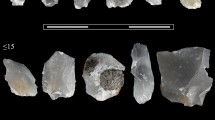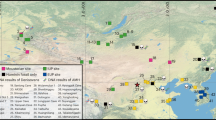Abstract
The oldest direct evidence of stone tool manufacture comes from Gona (Ethiopia) and dates to between 2.6 and 2.5 million years (Myr) ago1. At the nearby Bouri site several cut-marked bones also show stone tool use approximately 2.5 Myr ago2. Here we report stone-tool-inflicted marks on bones found during recent survey work in Dikika, Ethiopia, a research area close to Gona and Bouri. On the basis of low-power microscopic and environmental scanning electron microscope observations, these bones show unambiguous stone-tool cut marks for flesh removal and percussion marks for marrow access. The bones derive from the Sidi Hakoma Member of the Hadar Formation. Established 40Ar–39Ar dates on the tuffs that bracket this member constrain the finds to between 3.42 and 3.24 Myr ago, and stratigraphic scaling between these units and other geological evidence indicate that they are older than 3.39 Myr ago. Our discovery extends by approximately 800,000 years the antiquity of stone tools and of stone-tool-assisted consumption of ungulates by hominins; furthermore, this behaviour can now be attributed to Australopithecus afarensis.
This is a preview of subscription content, access via your institution
Access options
Subscribe to this journal
Receive 51 print issues and online access
$199.00 per year
only $3.90 per issue
Buy this article
- Purchase on Springer Link
- Instant access to full article PDF
Prices may be subject to local taxes which are calculated during checkout



Similar content being viewed by others
References
Semaw, S. et al. 2.5-million-year-old stone tools from Gona, Ethiopia. Nature 385, 333–336 (1997)
de Heinzelin, J. et al. Environment and behavior of 2.5-million-year-old Bouri hominids. Science 284, 625–629 (1999)
Wynn, J. G. et al. Geological and palaeontological context of a Pliocene juvenile hominin at Dikika, Ethiopia. Nature 443, 332–336 (2006)
Wynn, J. G. et al. in The Geology of Early Humans in the Horn of Africa (eds Quade, J. & Wynn, J. G.) 87–118 (GSA, 2008)
Alemseged, Z. et al. A juvenile early hominin skeleton from Dikika, Ethiopia. Nature 443, 296–301 (2006)
Alemseged, Z. et al. A new hominin from the Basal Member of the Hadar Formation, Dikika, and its geological context. J. Hum. Evol. 49, 499–514 (2005)
Blumenschine, R. J., Marean, C. W. & Capaldo, S. D. Blind tests of inter-analyst correspondence and accuracy in the identification of cut marks, percussion marks, and carnivore tooth marks on bone surfaces. J. Archaeol. Sci. 23, 493–507 (1996)
Capaldo, S. D. & Blumenschine, R. J. A quantitative diagnosis of notches made by hammerstone percussion and carnivore gnawing on bovid long bones. Am. Antiq. 59, 724–748 (1994)
Pickering, T. R. & Egeland, C. P. Experimental patterns of hammerstone percussion damage on bones: implications for inferences of carcass processing by humans. J. Archaeol. Sci. 33, 459–469 (2006)
Pickering, T. R., Egeland, C. P., Domínguez-Rodrigo, M., Brain, C. K. & Schnell, A. G. Testing the “shift in the balance of power” hypothesis at Swartkrans, South Africa: hominid cave use and subsistence behavior in the Early Pleistocene. J. Anthropol. Archaeol. 27, 30–45 (2008)
Chavaillon, J. in Earliest Man and Environments in the Lake Rudolf Basin (ed. Coppens, Y.) 565–573 (Chicago Univ. Press, 1976)
Kibunjia, M. Pliocene archaeological occurrences in the lake Turkana Basin, Kenya. J. Hum. Evol. 27, 159–171 (1994)
Kimbel, W. H. et al. Late Pliocene Homo and Oldowan tools from the Hadar Formation (Kada Hadar Member), Ethiopia. J. Hum. Evol. 31, 549–561 (1996)
Roche, H. et al. Early hominid stone tool production and technical skill 2.34 Myr ago in West Turkana, Kenya. Nature 399, 57–60 (1999)
Kimbel, W., Rak, Y. & Johanson, D. The Skull of Australopithecus afarensis (Oxford Univ. Press, 2004)
Panger, M. A., Brooks, A. S., Richmond, B. G. & Wood, B. Older than the Oldowan? Rethinking the emergence of hominin tool use. Evol. Anthropol. 11, 235–245 (2002)
Gifford-Gonzalez, D. Bones are not enough: analogues, knowledge, and interpretive strategies in zooarchaeology. J. Anthropol. Archaeol. 10, 215–254 (1991)
Domínguez-Rodrigo, M. & Barba, R. New estimates of tooth mark and percussion mark frequencies at the FLK Zinj site: the carnivore-hominid-carnivore hypothesis falsified. J. Hum. Evol. 50, 170–194 (2006)
Domínguez-Rodrigo, M. & Barba, R. Five more arguments to invalidate the passive scavenging version of the carnivore-hominid-carnivore model: a reply to Blumenschine et al. (2007a). J. Hum. Evol. 53, 427–433 (2007)
Behrensmeyer, A. K., Gordon, K. D. & Yanagi, G. T. Trampling as a cause of bone surface damage and pseudo-cutmarks. Nature 319, 768–771 (1986)
Domínguez-Rodrigo, M., de Juana, S., Galán, A. & Rodríguez, M. A new protocol to differentiate trampling marks from butchery cut marks. J. Archaeol. Sci. 36, 2643–2654 (2009)
Njau, J. K. & Blumenschine, R. J. A diagnosis of crocodile feeding traces on larger mammal bone, with fossil examples from the Plio-Pleistocene Olduvai Basin, Tanzania. J. Hum. Evol. 50, 142–162 (2006)
Bunn, H. T. Archaeological evidence for meat-eating by Plio-Pleistocene hominids from Koobi Fora and Olduvai Gorge. Nature 291, 574–577 (1981)
Blumenschine, R. J. & Selvaggio, M. M. Percussion marks on bone surfaces as a new diagnostic of hominid behaviour. Nature 333, 763–765 (1988)
White, T. D. Prehistoric Cannibalism at Mancos 5MTUMR-2346 (Princeton Univ. Press, 1992)
Fisher, J. W. J. Bone surface modifications in zooarchaeology. J. Archaeol. Method Theory 2, 7–68 (1995)
Bello, S. M. & Soligo, C. A new method for the quantitative analysis of cutmark micromorphology. J. Archaeol. Sci. 35, 1542–1552 (2008)
Campisano, C. J. Tephrostratigraphy and Hominin Paleoenvironments of the Hadar Formation, Afar Depression, Ethiopia. PhD thesis, Rutgers Univ. (2007)
Lisiecki, L. E. & Raymo, M. E. A. Plio-Pleistocene stack of 57 globally distributed benthic δ18O records. Paleoceanography 20, 522–533 (2005)
Dupont-Nivet, G. et al. in The Geology of Early Humans in the Horn of Africa (eds Quade, J. & Wynn, J. G.) 67–85 (GSA, 2008)
Acknowledgements
We thank the Authority for Research and Conservation of Cultural Heritage, the National Museum of Ethiopia, the Ministry of Tourism and Culture and the Afar regional government for permits and support; C. Mesfin, Z. Bedaso, T. Gebreselassie, Mesfin Mekonnen, H. Defar, A. Zerihun, G. Senbeto, Mogues Mekonnen, W. Aberra, T. Yifru and the people of the Dikika area for field assistance. We also thank the administration of Adaytu town and members of the Ethiopian armed forces. Funds for the 2009 field season were provided by the California Academy of Sciences. Travel expenses for D.G., S.P.M., D.R. and J.G.W. were covered by their respective institutions. C.W.M. and H.A.B. acknowledge the assistance of the research professionals in the John M. Cowley Center for High Resolution Electron Microscopy, LE-CSSS, ASU in conducting the ESEM imaging, and J. Thompson and S. Lansing for participating in the blind test. Z.A. thanks P. Mollard and K. Berge for assistance during fieldwork preparations.
Author information
Authors and Affiliations
Contributions
S.P.M. is the project archaeologist. Z.A. is the head of the project and palaeoanthropologist. C.W.M. described and analysed the fossil bone specimens and surface modifications. J.G.W. is the project geologist. Fauna were analysed by Z.A., D.R. (micromammals and GIS), D.G. (biostratigraphy), R.B. (palaeoenvironments). H.A.B. conducted the ESEM/SEI/EDX study. All authors contributed to the writing of this paper.
Corresponding author
Ethics declarations
Competing interests
The authors declare no competing financial interests.
Supplementary information
Supplementary Information
This file contains Supplementary Information comprising: 1 Survey Methodology; 2 Faunal list; 3 Stratigraphic and palaeoenvironmental context; 4 Surface modifications on the fossil specimens; Supplementary Figures 1- 23 with legends; Supplementary Tables 1- 3 and References. (PDF 12974 kb)
Rights and permissions
About this article
Cite this article
McPherron, S., Alemseged, Z., Marean, C. et al. Evidence for stone-tool-assisted consumption of animal tissues before 3.39 million years ago at Dikika, Ethiopia. Nature 466, 857–860 (2010). https://doi.org/10.1038/nature09248
Received:
Accepted:
Issue Date:
DOI: https://doi.org/10.1038/nature09248
This article is cited by
-
Language evolution and computational capabilities: conceptualization of the first language units
International Journal of Anthropology and Ethnology (2023)
-
From fossils to mind
Communications Biology (2023)
-
Reappraising the palaeobiology of Australopithecus
Nature (2023)
-
Tooth enamel nitrogen isotope composition records trophic position: a tool for reconstructing food webs
Communications Biology (2023)
-
Causal Cognition and Theory of Mind in Evolutionary Cognitive Archaeology
Biological Theory (2023)
Comments
By submitting a comment you agree to abide by our Terms and Community Guidelines. If you find something abusive or that does not comply with our terms or guidelines please flag it as inappropriate.



